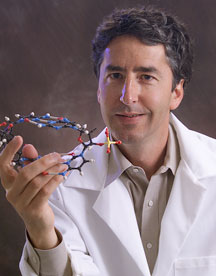

"Accelerated Evolution" Converts RNA Enzyme to DNA Enzyme In Vitro
By Eric Sauter
Scientists at The Scripps Research Institute have successfully converted an RNA enzyme (ribozyme) into a DNA enzyme (deoxyribozyme) through a process of accelerated in vitro evolution. The molecular conversion or transfer of both genetic information and catalytic function between these two different genetic systems, which are both based on nucleic acid-like molecules, is exactly what many scientists believe occurred during the very earliest period of earth's existence.
This "evolutionary conversion" provides a modern-day snapshot of how life as we understand it may have first evolved out of the earliest primordial mix of RNA-like molecules—sometimes referred to as the "pre-RNA world"—into a more complex form of RNA-based life (or the "RNA world") and eventually to cellular life based on DNA and proteins. Nucleic acids are large complex molecules that store and convey genetic information, but can also function as enzymes.
While the transfer of sequence information between two different classes of nucleic acid-like molecules—between RNA and DNA, for example—is straightforward because it relies on the one-to-one correspondence of the double helix pairing, transferring catalytic function is significantly more difficult because function cannot be conveyed sequentially. The present study demonstrates that the "evolutionary conversion" of an RNA enzyme to a DNA enzyme with the same function is possible, however, through the acquisition of a few critical mutations.
The study is being released in an advance online version of the journal Chemistry & Biology.
Scripps Research Professor Gerald F. Joyce, a member of the Skaggs Institute for Chemical Biology whose laboratory conducted the study, said, "During early life on earth both genetic information and catalytic function were thought to reside only in RNA. In our study, the evolutionary transition from an RNA to a DNA enzyme represents a genuine change, rather than a simple expansion, of the chemical basis for catalytic function. This means that similar evolutionary pathways may exist between other classes of nucleic acid-like molecules. These findings could help answer some fundamental questions concerning the basic structure of life and how it evolved over time."
As Francis Crick, the Nobel laureate who, along with James Watson uncovered the double helix structure of DNA, articulated in 1970, all known organisms operate according to the central dogma of molecular biology—that the transfer of sequential genetic information proceeds from nucleic acid to nucleic acid, and from nucleic acid to protein. But a far different situation exists with regard to the transfer of catalytic function, which does not occur sequentially in contemporary biology. The new study shows that catalytic function can be transmitted sequentially between two different nucleic acid-like molecules, suggesting how it might have been conveyed from pre-RNA molecules to RNA during the simpler pre-RNA world period.
There are several candidates for the initial pre-RNA molecule, all of which have the ability to form base-paired structures with themselves and with RNA. Cross-pairing would allow genetic information to be transferred from these pre-RNA molecules to RNA. The catalytic function of these early enzymes might have been transferred to a corresponding RNA enzyme following the acquisition of a few critical mutations, the study said, just as the evolutionary change of a ribozyme to a deoxyribozyme with the same or similar catalytic functions might also have occurred through random mutation and selection.
For the study, an RNA ribozyme was converted to a corresponding deoxyribozyme through in vitro evolution. The ribozyme was first prepared as a DNA molecule of the same RNA sequence but with no detectable catalytic activity. A large number of randomized variations of this DNA were prepared, and repeated cycles of in vitro evolution were carried out. The result was a deoxyribozyme with about the same level of catalytic activity as the original ribozyme.
"The use of in vitro evolution provides the means to convert a ribozyme to a corresponding deoxyribozyme rapidly," Joyce said. "In the laboratory these procedures allow us to carry out many generations of test tube evolution. The resulting molecules have interesting catalytic properties, they teach us something new about evolution, and they have potential application as therapeutic and diagnostic agents."
Other authors of the study include Natasha Paul and Greg Springsteen. The study was supported by the National Aeronautics and Space Administration, the National Institutes of Health, and Johnson & Johnson Research.
Send comments to: mikaono[at]scripps.edu

Professor Gerald F. Joyce's latest study provides a modern-day snapshot of how life as we understand it may have first evolved.
